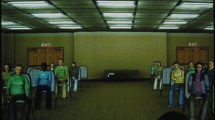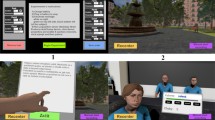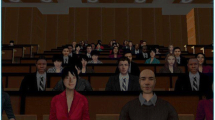Abstract
Fully immersive and stereoscopic Virtual Environments (VE) represent a powerful multimedia tool for laboratory-based simulations of distinct scenarios including scenarios for evaluating stressful situations resembling reality. Thus far, cortisol secretion as a neuroendocrine parameter of stress has not been evaluated within a Virtual Reality (VR)-based paradigm. In this study 94 healthy volunteers were subjected to a provocative VR-paradigm and a cognitive stress task. Provocative in this context means the VE was designed to provoke physiological reactions (cortisol secretion) within the respective users by purpose. It was tested (a) if a fully dynamic VE as opposed to a static VE can be regarded as a stressor and (b) if such a fully dynamic VE can modify an additional response to a cognitive stressor presented within the VE additionally. Furthermore, possible gender-related impacts on cortisol responses were assessed. A significant cortisol increase was observed only after the combined application of the fully dynamic VE and the cognitive stressor, but not after application of the dynamic VE or the cognitive stressor alone. Cortisol reactivity was greater for men than for women. We conclude that a fully dynamic VE does not affect cortisol secretion per se, but increases cortisol responses to a dual task paradigm that includes performance of a stressful mental task. This provides the basis for the application of VR-based technologies in neuroscientific research, including the assessment of the human Hypothalamus-Pituitary-Adrenal (HPA) axis regulation.
Similar content being viewed by others
References
Berger, M., Bossert, S., Krieg, J. C., Dirlich, G., Ettmeier, W., Schreiber, W., & von Zerssen, D. (1987). Interindividual differences in the susceptibility of the cortisol system: An important factor for the degree of hypercortisolism in stress situations? Biological Psychiatry, 22, 1327–1339.
Brandenberger, G., Follenius, M., Wittersheim, G., & Salame, P. (1980). Plasma catecholamines and pituitary adrenal hormones related to mental task demand under quiet and noise conditions. Biological Psychology, 10, 239–252.
Breier, A., Albus, M., Pickar, D., Zahn, T. P., Wolkowitz, O. M., & Paul, S. (1987). Controllable and uncontrollable stress in humans: Alterations in mood and neuroendocrine and psychophysiological function. American Journal of Psychiatry, 144, 1419–1425.
Bullinger, A. H. (2001). VE user physiological, cognitive and psychological needs. Deliverable to the European Commission, Contract No. IST-2000-26089, pp. 1–98.
Bullinger, A. H., Rössler, A., & Mueller-Spahn, F. (1998). From toy to tool: The development of immersive virtual reality environments for psychotherapy of specific phobias. In G. Riva (Ed.), Virtual reality in clinical psychology (pp. 103–111). Amsterdam: IOS.
Dai, Y., Ji, G., Huang, Y., Sun, X., & Dai, F. (1998, April) Changes of plasma endocrine hormone in pilots under Coriolis acceleration. Space Medicine and Medcal Engineering (Beijing), 11(2), 121–123.
Dess, N. K., Linwick, D., Patterson, J., Overmier, J. B., & Levine, S. (1983). Immediate and proactive effects of controllability and predictability on plasma cortisol responses to shocks in dogs. Behavioral Neuroscience, 97(6), 1005–1016.
Frankenhäuser, M., & Lundberg, U. (1982). Psychoneuroendocrine aspects of effort and distress as modified by personal control. In W. Bachmann & I. Udris (Eds.), Mental load and stress in activity European approaches (pp. 97–103). Amsterdam: North-Holland.
Frankenhäuser, M., Lundberg, U., & Forsman, L. (1980). Dissociation between sympathetic-adrenal and pituitary-adrenal responses to an achievement situation characterized by high controllability: Comparison between type A and type B males and females. Biological Psychology 10(2), 79–91.
Gelfin, Y., Lerer, B., Lesch, K. P., Gorfine, M., & Allolio, B. (1995). Complex effects of age and gender of hypothermic adrenocorticotrophic hormone and cortisol responses to ipsapirone challenge in normal subjects. Psychopharmacology, 120(3), 356–364.
Grigoriev, A. I., Nichiporuk, I. A., Yasnetsov, V. V., & Shashkov, V. S. (1988, April). Hormonal status and fluid electrolyte metabolism in motion sickness. Aviation Space and Environmental Medicine, 59(4), 301–305.
Hemmeter, U. (2000). Der Einfluss der Persönlichkeitsdisposition auf die Cortisolreaktion nach experimentellem Stress und Fasten - ein psycho-neuroendokrinologischer Ansatz der differentiellen Reagibilität der Persönlichkeit auf Stress, Psychologische Forschungsergebnisse, 343 S., Kovacs Verlag, Hamburg, Germany.
Hemmeter, U., Burkhard, H., Shaye, R., Holsboer-Trachsler, E., & Netter, P. (1999). Blunted cortisol response to different stressors in subjects scoring high on depression related personality traits. Pharmacopsychiatry, 32, 185.
Hennig, J., Lange, N., Haag, A., Rohrmann, S., & Netter, P. (2000, September) Reboxetine in a neuroendocrine challenge paradigm: Evidence for high cortisol responses in healthy volunteers scoring high on subclinical depression. International Journal of Neuropsychopharmacology, 3(3), 193–201.
Hennig, J., Toll, C., Schonlau, P., Rohrmann, S., & Netter, P. (2000) Endocrine responses after d-fenfluramine and ipsapirone challenge: Further support for Cloninger’s tridimensional model of personality. Neuropsychobiology, 41(1), 38–47.
Henry, J. P. (1992). Biological basis of stress response. Integrated Physiological and Behavioral Science, 27(1), 66–83.
Heuser, I. J., Gotthardt, U., Schweiger, U., Schmider, J., Lammers, C. H., Dettling, M., & Holsboer, F. (1994, March–April) Age-associated changes of pituitary-adrenocortical hormone regulation in humans: Importance of gender. Neurobiology of Aging, 15(2), 227–231.
Holsboer, F. (1999). The rationale for corticotropin-releasing hormone receptor (CRH-R) antagonists to treat depression and anxiety. Journal of Psychiatric Research, 33, 181–214.
Kern, P., & Breining, R. (1999). Experiences with interfaces for Virtual Environments in the field of engineering. In H.-J. Bullinger & J. Ziegler (Eds.), Human–Computer Interaction: Communication, Cooperation, and Application Design (Vol. 2), Proceedings of the 8th International Conference on Human–Computer Interaction (pp. 696–700). Mahwah, NJ: Erlbaum.
Kirschbaum, C., Gonzalez-Bono, E., Rohleder, N., Gessner, C., Pirke, K. M., Salvador, A., & Hellhammer, D. H. (1997). Effects of fasting and glucose load on free cortisol responses to stress and nicotine. Journal of Clinical Endocrinology and Metabolism, 82(4), 1101–1105.
Kirschbaum, C., & Hellhammer, D. H. (1989). Salivary cortisol in psychobiological research: An overview. Neuropsychobiology, 22, 150–169.
Kirschbaum, C., Klauer, T., Filipp, S. H., & Hellhammer, D. H. (1995). Sex-specific effects of social support on cortisol and subjective responses ot acute psychological stress. Psychosomatic Medicine, 57(1), 23–31.
Kirschbaum, C., Pirke, K. M., & Hellhammer, D. H. (1993). The “Trier Social Stress Test”—a tool for investigating psychobiological stress responses in a laboratory setting. Neuropsychobiology, 28(1–2), 76–81.
Lundberg, U. (1984). Human psychobiology in Scandinavia: II. Psychoneuroendocrinology—human stress and coping processes. Scandinavian Journal of Psychology, 25, 214–226.
Mason, J. W. (1975a). Emotion as reflected in patterns of endocrine integration. In L. Levi (Ed.), Emotions: Their parameters and measurement. New York: Raven.
Mason, J. W. (1975b). A historical view of the “stress” field, part I and II. Journal of Human Stress, 1(6–12), 22–36.
Netter, P., Hennig, J., & Huwe, S. (1997, October) Explanatory models of anxiety from the viewpoint of biopsychology and pharmacopsychology. Anesthesiologie Intensivmedizin Notfallmedizin Schmerztherapie, 32 (Suppl. 3), S325–S329.
Netter, P., Hennig, J., & Rohrmann, S. (1999, January). Psychobiological differences between the aggression and psychoticism dimension. Pharmacopsychiatry, 32(1), 5–12.
Post, R. M. (1992). Transduction of psychosocial stress into the neurobiology of recurrent affective disorder. American Journal of Psychiatry, 149, 999–1010.
Sachar, E. J., Hellman, L., & Fukushima, D. K. (1970). Cortisol production in depressive illness. Archives of General Psychiatry, 43, 878–884.
Selye, H. (1951). Das allgemeine Adaptationssyndrom als Grundlage für eine einheitliche Theorie der Medizin. Medizinische Wochenschrift, 70, 965–967, 1001–1003.
Selye, H. (1981). Geschichte und Grundzüge des Streß konzepts. In J. R. Nitsch (Ed.), Streß. (pp. 161–187). Bern, Switzerland: Hans Huber.
Steptoe, A., Fieldman, G., Evans, O., & Perry, L. (1996). Cardiovascular risk and responsivity to mental stress: The influence of age, gender, and risk factors. Journal of Cardiovascular Risk, 3(1), 83–93.
Vernikos-Danellis, J., & Heybach, J. P. (1980). Psychophysiologic mechanisms regulating the hypothalamic-pituitary-adrenal response to stress. In H. Selye (Ed.), Selye’s guide to stress research (Vol. 1, pp. 206–251). Torornto.
Author information
Authors and Affiliations
Corresponding author
Rights and permissions
About this article
Cite this article
Bullinger, A.H., Hemmeter, U.M., Stefani, O. et al. Stimulation of Cortisol During Mental Task Performance in a Provocative Virtual Environment. Appl Psychophysiol Biofeedback 30, 205–216 (2005). https://doi.org/10.1007/s10484-005-6378-y
Issue Date:
DOI: https://doi.org/10.1007/s10484-005-6378-y




